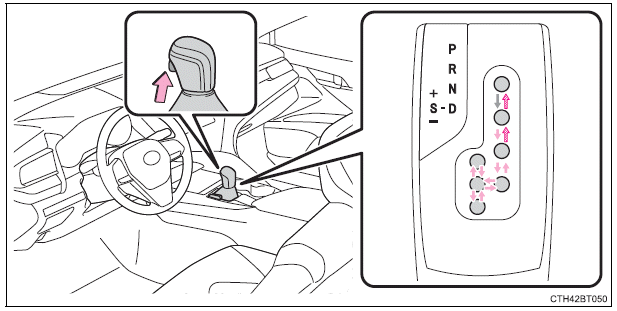Toyota Camry (XV70): Automatic transmission
Shifting the shift lever

 Vehicles without a smart key
system:
While the engine switch is in the "ON" position and the brake
pedal depressed*, shift the shift lever while pushing the shift
release button on the shift knob.
Vehicles without a smart key
system:
While the engine switch is in the "ON" position and the brake
pedal depressed*, shift the shift lever while pushing the shift
release button on the shift knob.
Vehicles with a smart key system: While the engine switch is in IGNITION ON mode and the brake pedal depressed*, shift the shift lever while pushing the shift release button on the shift knob.
 Shift the shift lever while
pushing the shift release button on
the shift knob.
Shift the shift lever while
pushing the shift release button on
the shift knob.
 Shift the shift lever normally.
Shift the shift lever normally.
When shifting the shift lever between P and D, make sure that the vehicle is completely stopped and the brake pedal is depressed.
*: For the vehicle be able to be shifted from P, the brake pedal must be depressed before the shift release button is pushed. If the shift release button is pushed first, the shift lock will not be released.
Shift position purpose
P - Parking the vehicle/starting the engine
R - Reversing
N - Neutral
D - Normal driving*1
S - S mode driving*2
*1: Shifting to the D position allows the system to select a gear suitable
for the
driving conditions. Setting the shift lever to the D position is recommended
for normal driving.
*2: Selecting shift ranges using S mode restricts the upper limit of the
possible
gear ranges, controls engine braking force, and prevents unnecessary
upshifting.

